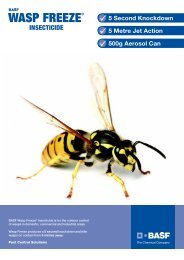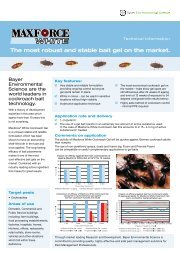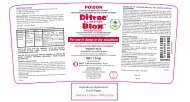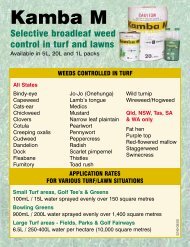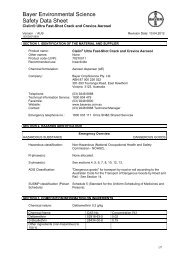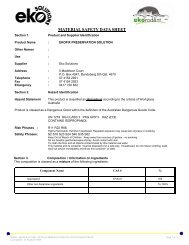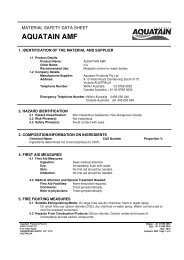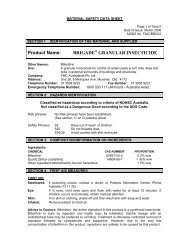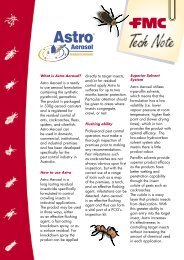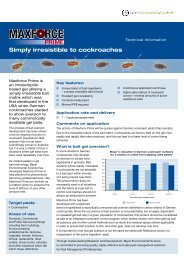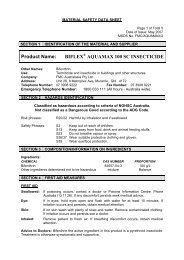BASF Pest Control Solutions Rodent Control Range - Garrards
BASF Pest Control Solutions Rodent Control Range - Garrards
BASF Pest Control Solutions Rodent Control Range - Garrards
Create successful ePaper yourself
Turn your PDF publications into a flip-book with our unique Google optimized e-Paper software.
<strong>BASF</strong> <strong>Pest</strong> <strong>Control</strong> <strong>Solutions</strong><br />
<strong>Rodent</strong> <strong>Control</strong> <strong>Range</strong>
Stratagem ®<br />
Highly potent single feed anticoagulant, in a<br />
palatable, securable bait block.<br />
A very potent rodenticide containing flocoumafen - a<br />
lethal dose can be consumed in a single feed. The highly<br />
palatable formulation controls rats and mice including<br />
those resistant to other anticoagulants. Its high toxicity to<br />
rodents means Stratagem ® can be placed using the pulse<br />
baiting technique thus reducing the labour requirement for<br />
treatment.<br />
Available in 8kg buckets.<br />
Sorexa ® Pro Gel<br />
A gel that combines palatability and efficacy<br />
for a quick and neat application.<br />
Clean professional solution for mouse control, it combines<br />
palatability with efficacy to provide an easily controlled and<br />
neat application. Sorexa ® Gel is a workable alternative to<br />
grain baits. Is easy to use, fast & precise to apply. Cost<br />
effective, up to 60 doses per 300g tube, with no spillage<br />
or waste. Ideal for sensitive environments such as where<br />
food is processed, stored or eaten.<br />
Available in 300g tubes.<br />
Sorexa ® Pro Blocks<br />
The best balance of palatability and durability<br />
in an efficacious block.<br />
A palatable rodenticide containing difenacoum- a multifeed<br />
anticoagulant effective against rats and mice. Sorexa ®<br />
Pro Blocks provide effective control in an easy to use<br />
formulation. It is versatile, economical and effective as loose<br />
bait without the risk of spillage. The advanced formulation<br />
helps to maintain effectiveness even under damp<br />
conditions. Exceptionally easy to use in a maintenance<br />
treatment program.<br />
Available in 10kg buckets.
Roguard ®<br />
Rat Stations<br />
The proven protection for your baits.<br />
Key Features<br />
• Strong and robust<br />
• Tamper resisting locks<br />
• Stackable for easy handling<br />
• Vertical and horizontal bait hangers<br />
• Takes a rat trap or liquid bait container<br />
• Several quick and easy anchorage options<br />
• Removable lid for easy cleaning<br />
The Roguard ® Rat Station has twin feeding chambers<br />
that will take loose bait, pellets, solid blocks or even liquid<br />
baits. It has been designed to accommodate a rat trap<br />
and also contains a pair of steel bait block holders which<br />
can be fixed either horizontally or vertically.<br />
Stackability<br />
The Roguard Rat Station has been designed to stack<br />
inside itself. This stackability allows for easy storage and<br />
transportation. The key advantage is the ability to carry<br />
more bait boxes whilst on site. Six boxes can be easily<br />
carried under one arm.<br />
Anchorage Options<br />
The Roguard Rat Station can be secured in place in a<br />
variety of ways. A number of knock-out holes in the rear<br />
wall can be utilised to hold the specially designed Wall<br />
Mounts or suitable bolts; a small hole in the base of the<br />
box takes either a Ground Stake or Ground Anchor; and<br />
small slots in the lid allow the box to be fixed to a structure<br />
using a wire rope.<br />
Roguard ®<br />
Mouse Stations<br />
Robust mouse box for use with all<br />
formulations.<br />
Key Features<br />
• Robust, compact construction<br />
• Tamper resisting lock<br />
• Hygienic and easy to clean<br />
• Twin bait chambers maximise efficacy<br />
Its compact polypropylene construction means it can be<br />
used in tight areas and is hygienic and easy to clean.<br />
Roguard ® Mouse Station has a tamper-resisting lock<br />
with a dedicated key, facilitating rapid inspection and<br />
bait replacement.<br />
The twin bait reservoirs ensure that bait is constantly on<br />
offer to the mice promoting maximum efficacy.
Rats<br />
Rats are a worldwide pest due to their capacity to cause<br />
structural damage, to spread life-threatening diseases,<br />
and to compete with man for food.<br />
Rats live alongside man, invading his buildings and eating his food.<br />
Rats transmit disease, which are potentially fatal to man such as<br />
Weil’s disease and murine typhus. They also carry organisms which<br />
can damage man’s health such as Salmonella bacteria, viruses and<br />
parasites such as nematodes and worms.<br />
Damage by rats to the fabric of buildings can be costly. Fires can<br />
easily be started after a rat has gnawed a cable. Gas and water<br />
pipes are also at risk and rat burrowing can undermine foundations<br />
and damage water courses.<br />
Physically very strong, rats have been known to survive<br />
for two days in open water, to swim a mile in open sea and<br />
to get through a gap of less than 25mm.<br />
Product Information Hotline: Free Call 1800 006 393<br />
www.termidor.com.au<br />
Always consult the product label before use.<br />
<strong>BASF</strong> Australia Ltd. Level 12, 28 Freshwater Place, Southbank VIC 3006.<br />
Disclaimer: The information submitted in this publication is based on current <strong>BASF</strong> knowledge and experience. In view of the many factors that may affect its application,<br />
this data does not relieve the user from carrying out their own tests. The data does not imply assurance of certain properties or of suitability for a specific purpose.<br />
It is the responsibility of the user to ensure that any proprietary rights and existing laws and legislation are observed. © Copyright <strong>BASF</strong> 2010.<br />
® Registered trademark of <strong>BASF</strong>.<br />
Mice<br />
First the danger, mice are more of a problem in buildings<br />
because they live indoors. They are more liable to cause fires<br />
by gnawing cables and they can damage insulation in animal<br />
housing causing costly heat loss and expensive replacement.<br />
Mice carry diseases such as salmonella and they can transmit a type<br />
of Leptospirosis. Their continual dribble of urine contaminates food<br />
and feedstuffs. They are a particular problem in poultry units and<br />
pig housing and a very real pest in grain stores, warehouses, shops,<br />
hospitals, and domestic premises.<br />
Being so small they are very easily carried, unnoticed, in egg boxes,<br />
food packaging, laundry baskets, etc. Entering a new location<br />
through gaps as small as 6mm, mice build nests which are hard to<br />
find, populating an area with new colonies quickly with devastating<br />
effect. Because mice can reach sexual maturity 42 days after birth,<br />
population grow much faster than those of rats, which take about<br />
twice the time to reach maturity.<br />
Rattus rattus Rattus norvegicus Mus domesticus<br />
Common names: Ship rat, Black rat, House rat, Roof rat<br />
Norway rat, Common rat, Brown rat, Wharf rat,<br />
Sewer rat<br />
House mouse<br />
Adult Weight: 200 grams 300 grams 15 grams<br />
Length:<br />
(head + body)<br />
150 - 220mm 200 - 250mm 60 - 90mm<br />
Length (tail): 180 - 250mm, usually longer than head and body 150 - 200mm, shorter than head and body 80 - 100mm, usually longer than the head & body<br />
Fur & colour:<br />
Ears & hearing:<br />
Smoother and softer than Rattus norvegicus. Usually<br />
black or grey.<br />
Thin, translucent, large and hairless.<br />
Excellent sense of hearing.<br />
Harsh and shaggy. Brown and black on upper head<br />
and body, grey or off white underneath.<br />
Thick, opaque, short with fine hairs. Excellent sense<br />
of hearing.<br />
Brownish grey. Lighter shades occur.<br />
Large with some hairs. Excellent sense of hearing.<br />
Eyes & sight: Large and prominent. Poor sight, colour blind. Small. Poor sight, colourblind. Small, poor sight, colour blind<br />
Snout, smell<br />
and taste:<br />
Pointed, excellent sense of smell and taste Blunt, excellent sense of smell and taste Pointed, excellent sense of smell & taste<br />
Droppings:<br />
Habits &<br />
habitat:<br />
Feeding habits:<br />
Scattered. Spindle or banana-shaped,<br />
about 12mm long.<br />
Non-burrowing. Nests mainly in walls, attics, vines<br />
and trees. Active agile climber, rarely found in<br />
sewers. Rather more erratic and unpredictable in<br />
habit than Rattus norvegicus. Less wary of new<br />
objects than Rattus norvegicus. <strong>Range</strong> 30 metres.<br />
Omnivorous, mainly fruits, nuts, grains and<br />
vegetables. Consumes 25 - 30 grams per day, drinks<br />
water or eats food with high water content.<br />
In groups, but sometimes scattered.<br />
Ellipsoidal capsule shaped,<br />
about 20mm long.<br />
Does burrow. Lives outdoors, indoors and in sewers.<br />
Nests in burrows. Can climb, though not agile. Very<br />
good swimmer. Conservative, somewhat predictable<br />
in habit. Will avoid unfamiliar objects, e.g. bait trays,<br />
placed on runs, for some days.<br />
Need to gnaw to keep their constantly growing<br />
incisor teeth worn down. Creatures of habit; will<br />
leave regular runs to & from feeding areas.<br />
Omnivorous, more likely to eat meat than Rattus<br />
rattus. Consumes up to 30 grams per day, drinks<br />
water or eats food with high water content. Will<br />
hoard food for future consumption. Most likely to eat<br />
at night. <strong>Range</strong> 50 metres when looking for food.<br />
Scattered, rod shaped, 3-6mm long<br />
Life cycle: 9 - 12 months 9 - 18 months Span 9 - 12 months<br />
Sexual maturity: 2 - 3 months 2 - 3 months 7 weeks.<br />
Litter size:<br />
Maximum<br />
6 - 10 offspring 8 - 10 offspring 5 - 6 offspring<br />
reproduction<br />
rate:<br />
6 litters per year 7 litters per year 8 litters per year<br />
Sometimes burrows. Lives indoors & outdoors but<br />
is almost unknown in sewers. Nest generally within<br />
stored materials but may burrow. Climbs.<br />
Eratic in habit. Inquisitive towards new objects.<br />
<strong>Range</strong> 1.5 – 5 metres.<br />
Nibbles. Prefers cereals. Consumes 3 grams per day.<br />
Unlike rats, can survive with very little water & often<br />
obtains sufficient water in food without the need to<br />
drink.



